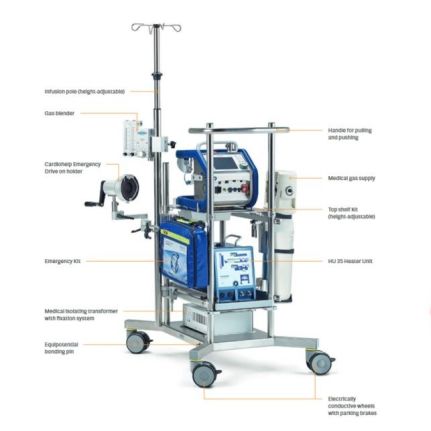How Does ECMO Machine Used to Save COVID-19 Patient’s Life?

In January 2020, the coronavirus was still relatively new, had only infected patients in Wuhan and the world had no clue how life would change drastically. Soon enough WHO declared the coronavirus disease as a public health emergency and released guidelines on how to go about managing patients who were infected by it.
COVID-19 is known to affect the lungs primarily while causing pneumonia, but multiple (if not all) patients also develop accurate respiratory distress syndrome (ARDS) almost immediately. In order to treat patients with ARDS, WHO declared interim guidelines to give patients with refractory hypoxemia at tertiary healthcare centers that are equipped to provide extracorporeal membrane oxygenation (ECMO).
ECMO Machines?
ECMO, which is the abbreviation for Extracorporeal Membrane Oxygenation is a specialized and very expensive form of treatment for patients with severe lung and heart failure. It effectively pumps (and oxygenates) blood outside the body in an effort to heal the patient when their lungs/heart are too inflamed or damaged. This resource-intensive machine is the ultimate form of life support. They are rather effective and have become even more famous since the outbreak of the novel coronavirus.
Are ECMO Machines Really the Solution?
There is evidence that patients on the ECMO machine recovered a lot better and faster when performed at specialized high-volume centers. Besides, the use of ECMO machines in ARDS has always been known to lower the potential risk of death, which is why its use right now only seems vital, what with more than 1,00,000 deaths worldwide.
But even with WHO backing up the requirement for ECMO machines to fight COVID-19, many medical experts are conflicted. Since there are many unknown factors on the virus itself, the criteria for the selection of patients that require ECMO is undetermined. Many say that it has a role in treating refractory hypoxemia, but this is still an assumption at best.
When Does a Patient Need the Help of an ECMO Machine?
Those who are known to have symptoms of coronavirus are expected to stay at home with social distancing as their #1 priority. Self-isolation should do the trick if you’re displaying mild symptoms of the disease. However, some people develop symptoms slightly more serious that “mild”- this may be breathing difficulty or severe wheezing. That’s when you know you have to call for medical help.
COVID-19 patients who display severe illness must be admitted to the hospital. There are various checks and tests the medical professionals will perform on you to consider the apt treatment option. Apart from the coronavirus test, they will first check your blood oxygen levels, which gives the doctor an idea of how well your lungs are working. The next one is a blood pressure test to make sure there’s no strain on the heart or vascular system.
Depending on the results, the doctor will put you on one of the 4 treatment stages (the most severe of which involves an ECMO machine).
• Basic Oxygen Therapy
If you’re breathless and struggling to get enough oxygen into your lungs and blood, the most basic form of treatment is oxygen therapy. This involves a mask fitted to your mouth as oxygen-filled air flows into your mouth to help you breathe better.
• Pressurized Oxygen Therapy
When the basic oxygen therapy is not quite enough, a more intensive form of therapy is required for oxygen to reach the patient’s bloodstream. In pressurized oxygen therapy, the patients remain conscious and are fitted with an air-tight mask as oxygen-enriched gas is given to them in a pressurized form. Also, doctors will keep a closer eye on you to check your vitals.
• Mechanical Ventilation
If the patient still has difficulty breathing, they may require the help of a ventilator in the Intensive Care Unit. This is a rather invasive procedure that artificially pushes air in and out of your lungs. Patients do not stay conscious of this method of oxygenation. A tube is often inserted into the patient’s mouth or a surgically created hole in the neck which goes down their windpipe. Since it also removes the carbon dioxide from the lungs, it is referred to as “ventilation”. This machine has been very effective for patients fighting extreme cases of COVID-19.
• Extracorporeal Membrane Oxygenation (ECMO)
When the patient’s lungs are too inflamed or damaged for a mechanical ventilator, it’s time for them to adapt ECMO to get enough oxygen into their blood. An ECMO machine is used in such cases and is the most aggressive form of life support. It is often referred to as the “last resort” for patients suffering from COVID-19.
